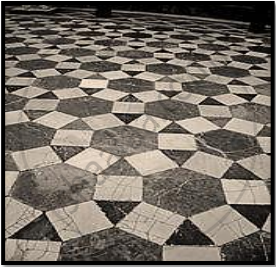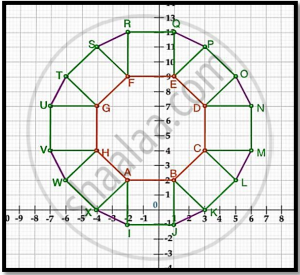Advertisements
Advertisements
प्रश्न
Find the ratio in which the line segment joining (-2, -3) and (5, 6) is divided by x-axis Also, find the coordinates of the point of division in each case.
उत्तर
The ratio in which the x−axis divides two points `(x_1,y_1)` and `(x_2,y_2)` is λ : 1
The ratio in which the y-axis divides two points `(x_1,y_1)` and `(x_2,y_2)` is μ : 1
The coordinates of the point dividing two points `(x_1,y_1)` and `(x_2,y_2)` in the ratio m:n is given as,
`(x,y) = (((lambdax_2 + x_1)/(lambda + 1))","((lambday_2 + y_1)/(lambda + 1)))` Where `lambda = m/n`
Here the two given points are A(−2,−3) and B(5,6).
The ratio in which the x-axis divides these points is `(6lambda - 3)/3 = 0`
`lambda = 1/2`
Let point P(x, y) divide the line joining ‘AB’ in the ratio 1:2
Substituting these values in the earlier mentioned formula we have
`(x,y) = (((1/2(5) + (-2))/(1/2 + 1))","((1/2(6) + (-3))/(1/2 + 1)))`
`(x,y) = ((((5 + 2(-2))/2)/((1 + 2)/2))","(((6 + 2(-3))/2)/((1 + 2)/2)))`
`(x,y) = ((1/3)","(0/3))`
`(x,y) = (1/3 , 0)`
Thus the ratio in which the x−axis divides the two given points and the co-ordinates of the point is `(1/3, 0)`
APPEARS IN
संबंधित प्रश्न
Prove that the points (3, 0), (6, 4) and (-1, 3) are the vertices of a right-angled isosceles triangle.
Which point on the y-axis is equidistant from (2, 3) and (−4, 1)?
Find the third vertex of a triangle, if two of its vertices are at (−3, 1) and (0, −2) and the centroid is at the origin.
Find the value of x such that PQ = QR where the coordinates of P, Q and R are (6, -1), (1, 3) and (x, 8) respectively.
Name the quadrilateral formed, if any, by the following points, and given reasons for your answers:
A(4, 5) B(7, 6), C (4, 3), D(1, 2)
The line segment joining the points P(3, 3) and Q(6, -6) is trisected at the points A and B such that Ais nearer to P. If A also lies on the line given by 2x + y + k = 0, find the value of k.
Show that the points A (1, 0), B (5, 3), C (2, 7) and D (−2, 4) are the vertices of a parallelogram.
Show hat A(1,2), B(4,3),C(6,6) and D(3,5) are the vertices of a parallelogram. Show that ABCD is not rectangle.
Find the area of a quadrilateral ABCD whose vertices area A(3, -1), B(9, -5) C(14, 0) and D(9, 19).
Point P(x, 4) lies on the line segment joining the points A(−5, 8) and B(4, −10). Find the ratio in which point P divides the line segment AB. Also find the value of x.
The ordinate of any point on x-axis is
What is the distance between the points (5 sin 60°, 0) and (0, 5 sin 30°)?
Find the coordinates of the point which is equidistant from the three vertices A (\[2x, 0) O (0, 0) \text{ and } B(0, 2y) of ∆\] AOB .
If three points (0, 0), \[\left( 3, \sqrt{3} \right)\] and (3, λ) form an equilateral triangle, then λ =
f the coordinates of one end of a diameter of a circle are (2, 3) and the coordinates of its centre are (−2, 5), then the coordinates of the other end of the diameter are
Find the point on the y-axis which is equidistant from the points (S, - 2) and (- 3, 2).
A point both of whose coordinates are negative will lie in ______.
Which of the points P(0, 3), Q(1, 0), R(0, –1), S(–5, 0), T(1, 2) do not lie on the x-axis?
A tiling or tessellation of a flat surface is the covering of a plane using one or more geometric shapes, called tiles, with no overlaps and no gaps. Historically, tessellations were used in ancient Rome and in Islamic art. You may find tessellation patterns on floors, walls, paintings etc. Shown below is a tiled floor in the archaeological Museum of Seville, made using squares, triangles and hexagons.

A craftsman thought of making a floor pattern after being inspired by the above design. To ensure accuracy in his work, he made the pattern on the Cartesian plane. He used regular octagons, squares and triangles for his floor tessellation pattern

Use the above figure to answer the questions that follow:
- What is the length of the line segment joining points B and F?
- The centre ‘Z’ of the figure will be the point of intersection of the diagonals of quadrilateral WXOP. Then what are the coordinates of Z?
- What are the coordinates of the point on y-axis equidistant from A and G?
OR
What is the area of Trapezium AFGH?
Assertion (A): Mid-point of a line segment divides the line segment in the ratio 1 : 1
Reason (R): The ratio in which the point (−3, k) divides the line segment joining the points (− 5, 4) and (− 2, 3) is 1 : 2.
